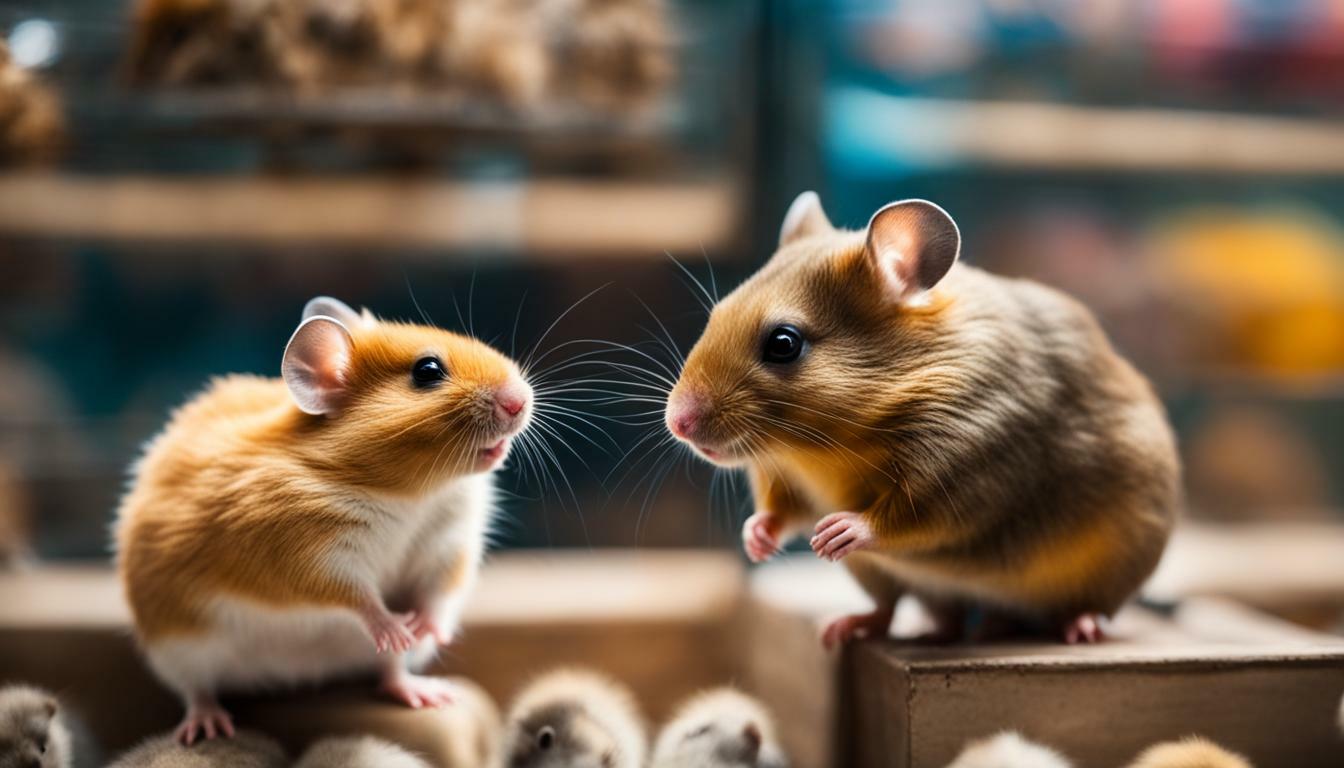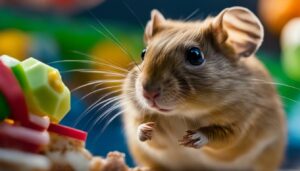If you’ve ever wondered whether hamsters and mice can breed, the answer is no due to their genetic incompatibility. Crossbreeding between these two species is not possible due to their distinct genetic differences. Even if fertilization occurs artificially, the embryos do not develop and eventually die. Hamsters and mice are not closely related genetically, and their nuclei and cytoplasm are not compatible for successful breeding. It is important to understand the limitations of their genetic compatibility to ensure the well-being of these small pets.
Key Takeaways:
- Hamsters and mice cannot breed due to their genetic differences and incompatibility.
- Even with artificial fertilization, the embryos do not develop and eventually die.
- Hamsters and mice should be kept in separate enclosures to avoid aggression and stress.
- Mice and hamsters have different behaviors, sizes, and temperaments, making them unsuitable for living together.
- It is recommended to provide separate housing for mice and hamsters to ensure their well-being.
Understanding the Genetic Differences
To understand why hamsters and mice cannot breed, it’s essential to explore the genetic differences between the two species and their reproductive behaviors. While hamsters and mice both belong to the Rodentia order, they are not closely related genetically. Their nuclei and cytoplasm are not compatible for successful breeding, making crossbreeding impossible.
Hamsters have a diploid chromosome number of 44, while mice have a diploid chromosome number of 40. This difference in chromosome numbers prevents the successful combination of genetic material during fertilization. Even if artificial fertilization is attempted, the embryos do not develop properly and fail to survive. This is because the genetic incompatibility between hamsters and mice hinders the normal process of embryo development.
In addition to their genetic differences, hamsters and mice have distinct reproductive behaviors. Hamsters are solitary animals that prefer to live alone, while mice are social creatures that thrive in groups. This difference in social behavior further reinforces the incompatibility between the two species. When housed together, hamsters may exhibit aggressive behavior towards mice, leading to stress and potential harm for both animals.
| Hamsters | Mice |
|---|---|
| Solitary animals | Social animals |
| Chromosome number: 44 | Chromosome number: 40 |
| Unsuitable for living with mice | Unsuitable for living with hamsters |
In summary, the genetic differences between hamsters and mice prevent them from successfully breeding. Their nuclei and cytoplasm are not compatible, and even if artificial fertilization is attempted, the embryos fail to develop properly. Additionally, their different reproductive behaviors, with hamsters being solitary and mice being social, make it unsuitable for them to live together. It is important to provide separate enclosures for mice and hamsters to ensure their well-being and prevent any aggression or stress.
Artificial Fertilization and Embryo Development
Even if attempts are made for artificial fertilization between hamsters and mice, the embryos do not develop and eventually perish due to their genetic incompatibility. The two species have significant genetic differences, which prevent successful crossbreeding. Hamsters and mice have no interest in breeding with each other, and their nuclei and cytoplasm are incompatible for successful embryo development.
Despite efforts to artificially fertilize the eggs of hamsters with the sperm of mice, the embryos fail to develop beyond early stages. This is because the genetic material from both species cannot align properly to support normal growth and development. The embryos lack the necessary genetic instructions to form viable offspring, leading to their eventual demise.
Table: Embryo Development in Crossbred Hamsters and Mice
| Stage | Development |
|---|---|
| Fertilization | Successful crossbreeding is not possible. |
| Early Stage | The embryos lack necessary genetic instructions for normal development. |
| Growth and Differentiation | The embryos fail to grow and develop into viable offspring. |
| Outcome | Embryos do not survive and perish due to genetic incompatibility. |
Given the genetic differences and the inability of hamsters and mice to produce viable offspring, it is clear that breeding hamsters and mice together is not possible. Therefore, it is recommended to keep these species in separate enclosures to ensure their well-being and prevent any potential stress or aggression that may arise from attempting to house them together.
Keeping Mice and Hamsters Together
It is not recommended to keep mice and hamsters together in the same cage due to their different behaviors, sizes, and temperaments. Hamsters are solitary animals by nature, preferring to live alone and stake their claim on their territory. On the other hand, mice are social creatures that thrive in groups. Putting these two species together can lead to territorial disputes, aggression, and stress.
Hamsters are generally larger and more territorial compared to mice. They can become aggressive towards other rodents, including mice, which can result in injuries and potential harm to both animals. Additionally, hamsters have specific requirements for their living space, such as bedding depth and types of enrichment, which might not be suitable for mice. Co-housing these species in the same cage can create an environment that is unsuitable for both hamsters and mice.
Table 1: Comparison of Behaviors, Sizes, and Temperaments of Hamsters and Mice
| Hamsters | Mice | |
|---|---|---|
| Behavior | Solitary | Social |
| Size | Larger | Smaller |
| Temperament | Territorial and aggressive towards other rodents | Social and adaptable |
Providing separate enclosures for mice and hamsters is crucial to ensure their well-being. This allows each species to have their own space, providing them with the freedom to exhibit their natural behaviors and reduce the risk of conflict or stress. By creating suitable environments that meet the specific needs of hamsters and mice, pet owners can ensure the happiness and health of their furry companions.
Potential Risks of Housing Mice and Hamsters Together
Housing mice and hamsters together can lead to various risks, including competition, aggression, and stress, due to their different nature and behaviors. These small rodents have distinct territorial instincts and social structures, making it challenging for them to coexist peacefully in the same enclosure. Interactions between mice and hamsters can result in heightened aggression, leading to injuries or even fatal consequences. To ensure the well-being of both species, it is crucial to provide separate enclosures and avoid attempting to house them together.
Mice are highly social animals that thrive in groups, whereas hamsters are solitary creatures that prefer to live alone. When forced to live together, mice may exhibit dominant behavior, competing for resources like food, water, and hiding spots. This competition can lead to increased stress levels and compromised welfare for both mice and hamsters. Additionally, the natural predatory instincts of mice can trigger fear and distress in hamsters, further escalating the potential risks of aggression.
The physical differences between mice and hamsters also contribute to the risks of housing them together. Mice are generally smaller and more agile than hamsters, making it easier for them to overpower their hamster counterparts. This power imbalance can result in injuries or even death for the hamsters. Furthermore, the distinct temperaments and behaviors of mice and hamsters can clash when confined in close quarters, heightening the risks of aggression and stress.
To ensure the well-being of both your mice and hamsters, it is essential to provide separate enclosures that cater to their specific needs. Each species should have adequate space, enrichment items, and resources to thrive and feel secure. By avoiding housing mice and hamsters together, you can minimize the risks of competition, aggression, and stress, allowing each small pet to live a happy and healthy life.
| Risks of Housing Mice and Hamsters Together |
|---|
| Competition for resources like food, water, and hiding spots |
| Heightened aggression and potential injuries |
| Increased stress levels and compromised welfare |
| Power imbalance between smaller, more agile mice and hamsters |
| Clashing temperaments and behaviors |
Providing Separate Enclosures for Mice and Hamsters
To ensure the well-being of both mice and hamsters, it is crucial to provide separate enclosures that cater to their specific needs and behaviors. While it may be tempting to house them together for convenience, doing so can lead to various issues, including competition, aggression, and stress for both species.
Mice and hamsters have different behaviors, sizes, and temperaments that make them unsuitable companions for each other. Hamsters are solitary animals, preferring to live alone and defend their territory, while mice are social creatures that thrive in groups. Placing them together can result in territorial disputes and physical harm.
Hamsters
| Traits | Enclosure Requirements |
|---|---|
| Hamsters are solitary animals | Provide a spacious enclosure with hiding spots |
| They require ample space for exercise | Include a wheel and tunnels for stimulation |
| Hamsters prefer a quiet environment | Avoid placing their enclosure in a noisy area |
Mice
| Traits | Enclosure Requirements |
|---|---|
| Mice are social animals | House them in groups of the same sex |
| They require ample space for exploration | Provide multiple levels and toys for enrichment |
| Mice thrive in an active environment | Include a wheel and various climbing structures |
By keeping mice and hamsters in separate enclosures, you can ensure they have the appropriate space and resources to meet their individual needs. This promotes their overall well-being and reduces the likelihood of stress or conflict. Remember to provide each species with suitable bedding, food, and water sources, and regularly clean their enclosures to maintain hygiene.
While it’s important to prioritize the health and happiness of your small pets, it’s also crucial to consult with a veterinarian specializing in rodents for personalized advice. They can offer guidance on specific breeds, behavior, and any additional considerations to ensure the optimal care for your mice and hamsters.
The Unique Traits of Hamsters
Hamsters possess unique traits such as their behaviors, sizes, and temperaments that make them incompatible with living alongside mice. These small furry creatures are known for their solitary nature, preferring to live alone rather than in social groups like mice. This solitary behavior, combined with their territorial instincts, can lead to aggression towards other rodents, including mice. Hamsters are best suited to living in separate enclosures where they can establish their own territories and live without the stress of competition or potential conflicts with other rodents.
When it comes to sizes, hamsters are generally larger than mice. They have a stockier build and can grow to be up to six inches long. Their larger size can sometimes be intimidating to mice, and mixing the two species in the same cage can lead to territorial disputes and potential harm to either or both animals.
Another important factor to consider is the difference in temperaments between hamsters and mice. Hamsters are known for their more independent and less social nature compared to mice. They are not typically inclined to interact and live harmoniously with other rodents. On the other hand, mice are more social animals that thrive in the company of their own species. Mixing the two species can cause stress and discomfort for both the hamsters and the mice, ultimately compromising their well-being.
| Traits | Hamsters | Mice |
|---|---|---|
| Behavior | Solitary | Social |
| Size | Larger | Smaller |
| Temperament | Independent | Social |
In conclusion, while hamsters and mice may share some similarities as small pet rodents, they are not compatible for cohabitation. Hamsters possess unique traits such as their behaviors, sizes, and temperaments that make them unsuitable for living with mice. It is important to prioritize the well-being of these animals by providing separate enclosures and ensuring they can thrive in environments that cater to their specific needs.
The Unique Traits of Mice
Mice exhibit distinct traits, including their behaviors, sizes, and temperaments, which can potentially lead to conflict when cohabitating with hamsters. Understanding these differences is crucial for the well-being of both species.
Behaviors: Mice are highly social creatures and thrive in groups. They engage in complex social interactions, such as grooming and scent marking, which are essential for their communication and bonding. However, hamsters are solitary animals and prefer to have their own space without the presence of other rodents. This difference in social behavior can result in stress and aggression if mice and hamsters are housed together.
Sizes: Mice are generally smaller in size compared to hamsters. Their petite nature allows them to explore small crevices and move swiftly. On the other hand, hamsters are larger and more robust, adapted for their burrowing habits. The size discrepancy can create a power imbalance and potential territorial conflicts between the two species.
Temperaments: Mice are known for their curious and adventurous nature. They are constantly on the move, exploring their surroundings and seeking new stimuli. Hamsters, however, are more cautious and prefer a quieter and less stimulating environment. Mismatched temperaments can lead to stress and aggression, as the constant activity of mice may disturb the more reserved nature of hamsters.
| Species | Behaviors | Sizes | Temperaments |
|---|---|---|---|
| Mice | Social, engage in grooming and scent marking | Smaller and agile | Curious and adventurous |
| Hamsters | Solitary, prefer own space | Larger and robust | Cautious and reserved |
Recommendations for Small Pet Owners
If you are a small pet owner with both hamsters and mice, it is crucial to follow recommendations that prioritize the well-being of these pets, including providing separate housing. As mentioned earlier, crossbreeding between hamsters and mice is not possible due to their genetic differences. Therefore, it is best to avoid any attempts at breeding these two species together.
Hamsters are solitary animals by nature and can be aggressive towards other rodents, including mice. To prevent potential conflicts or injuries, it is essential to keep them in separate enclosures. This will ensure their safety and minimize any stress or discomfort caused by living in close proximity.
Mice and hamsters also have different behaviors, sizes, and temperaments, which can further contribute to the need for separate housing. Mice are social creatures and thrive in groups, whereas hamsters prefer to live alone. Housing them together can lead to competition for resources, aggression, and stress, which can negatively impact their overall well-being.
Recommended Care Guidelines
Here are some additional recommendations for small pet owners with both hamsters and mice:
- Provide each pet with their own suitable enclosure, ensuring they have enough space, proper bedding, and hiding spots.
- Give each pet their own food and water dishes to prevent disputes over resources.
- Handle each pet separately to prevent any potential territorial or aggressive behaviors caused by interaction with the other species.
- Regularly clean and maintain their enclosures to promote a clean and hygienic environment.
- Monitor their behavior and overall health, seeking veterinary care if any concerns arise.
By following these recommendations, you can create a safe and comfortable environment for your hamsters and mice, ensuring their individual needs are met. Prioritizing their well-being will contribute to their overall health and happiness as beloved small pets in your home.
| Summary of Recommendations for Small Pet Owners |
|---|
| Provide separate housing for hamsters and mice |
| Ensure each pet has their own enclosure with enough space and suitable amenities |
| Give each pet their own food and water dishes |
| Handle each pet separately to prevent conflicts |
| Maintain clean and hygienic enclosures |
| Monitor their behavior and health |
| Seek veterinary care for any concerns |
Conclusion
In conclusion, hamsters and mice cannot breed due to their genetic differences, and it is best to keep them in separate enclosures for their well-being.
Crossbreeding between hamsters and mice is not possible, as the two species have no interest in breeding with each other. Even if artificial fertilization is attempted, the embryos do not develop and eventually die. This is because hamsters and mice are not closely related genetically, and their nuclei and cytoplasm are not compatible for successful breeding.
Furthermore, it is not recommended to house mice and hamsters together in the same cage. Hamsters are solitary animals and can be aggressive towards other rodents. Mixing them with mice can lead to competition, aggression, and stress for both species.
It is important to recognize that mice and hamsters have different behaviors, sizes, and temperaments. These differences can cause conflict and potential harm if they are forced to live together. Therefore, providing separate enclosures for mice and hamsters is the best approach to ensure their well-being and minimize any risk of harm.
FAQ
Can hamsters and mice breed?
No, crossbreeding between hamsters and mice is not possible due to their genetic differences. The two species have no interest in breeding with each other, and even if fertilization occurs artificially, the embryos do not develop and eventually die.
Is it recommended to keep mice and hamsters together in the same cage?
No, keeping mice and hamsters together in the same cage is not recommended. Hamsters are solitary animals and can be aggressive towards other rodents. Mice and hamsters have different behaviors, sizes, and temperaments, which can lead to competition, aggression, and stress if they are forced to live together.
Why is crossbreeding between hamsters and mice not possible?
Crossbreeding between hamsters and mice is not possible due to their genetic differences. Hamsters and mice are not closely related genetically, and their nuclei and cytoplasm are not compatible for successful breeding.
What are the potential risks of housing mice and hamsters together?
Housing mice and hamsters together can result in competition, aggression, and stress. Due to their different behaviors and temperaments, these species may not get along and can harm each other.
How should I house mice and hamsters to ensure their well-being?
It is best to provide separate enclosures for mice and hamsters to ensure their well-being. This allows each species to have their own space and avoids conflicts or harm between them.




